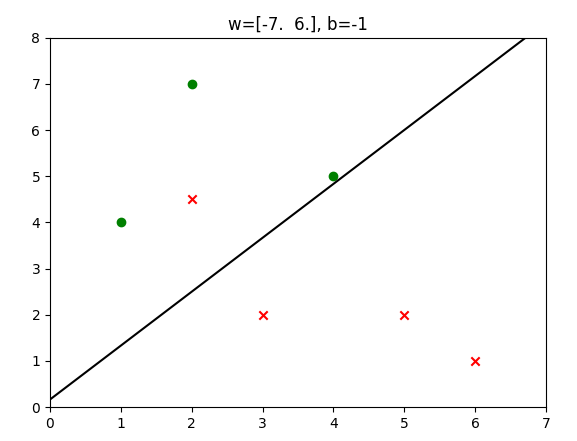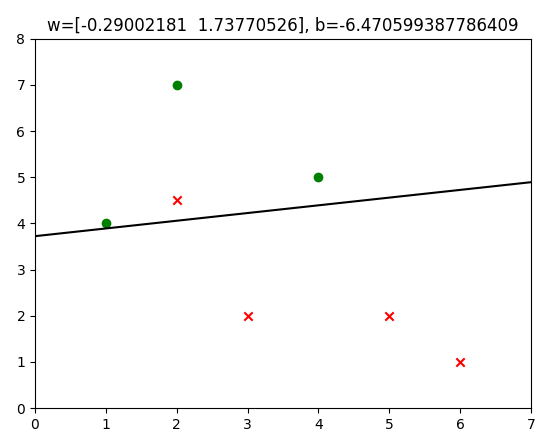标签:mamicode line pen 过程 ima pytho 学习 矩阵 噪声
系列文章目录:
今天我们一起来学习使用非常广泛的分类算法:逻辑回归,是的,你没有看错,虽然它名字里有回归,但是它确实是个分类算法,作为除了感知机以外,最最最简单的分类算法,下面我们把它与感知机对比来进行学习;
以上,对于数据中的噪声,假设噪声点实际为负类,但是被分到正类一侧,如果是感知机,则无法判断,而逻辑回归以概率为基础,如果该噪声点实际被分为正类的概率仅为52%,那么实际上它属于负类的可能性也很大,即逻辑回归认为数据的产生是有一定随机性的,相比于简单的0或1,概率值更能表现其实际情况;
从决策边界可知,感知机的输出∈{+1,-1},而逻辑回归的输出为0~1的概率值:
如何看待逻辑回归选择Sigmoid作为概率输出函数呢,可以从以下几个点来理解:
Sigmoid给出了条件概率:
首先列出损失函数如下:
对上述函数针对参数w求梯度:
上述梯度就是后续我们用于更新参数w的依据;
def __init__(self,X,y,epochs=5000,eta=0.1,epsilon=0.001):
super(LogisticRegression,self).__init__(X,y)
self.epochs = epochs
self.eta = eta
self.epsilon = epsilon
self.wk = np.array([0 for i in range(self.X.shape[1])])
def sigmoid(self,x):
return 1/(1+np.exp(-x))
def drhd(self,w):
‘‘‘
经验误差函数的梯度
‘‘‘
ew = []
for i in range(self.X.shape[1]):
ewi = np.mean(-self.y*self.X[:, i]*np.exp(-self.y*(self.X@w))/(1+np.exp(-self.y*(self.X@w))))
ew.append(ewi)
return np.array(ew)
def train(self):
i_,norm = None,None
for i in range(self.epochs):
drhdwk = self.drhd(self.wk)
i_,norm = i,np.linalg.norm(drhdwk)
if np.linalg.norm(drhdwk) < self.epsilon:
break
self.wk = self.wk-self.eta*drhdwk
return i_,norm,self.wk
先看下感知机-口袋算法处理非线性分类问题:

再来对比看下逻辑回归的分类情况:

直觉上看,二者虽然都有一个点分类错误(这是肯定的,因为数据不是线性可分的),但是对于分类错误的×来说,逻辑回归中错误的×距离分割平面更近,也就是说模型对于这个点的判断是比较模糊而不是很肯定的,可以认为是错的不严重,这一点也会反应在损失函数中;
import numpy as np
from 线性回归最小二乘法矩阵实现 import LinearRegression as LR
from sklearn.datasets import load_iris
import matplotlib.pyplot as plt
class LogisticRegression(LR):
def __init__(self,X,y,epochs=5000,eta=0.1,epsilon=0.001):
super(LogisticRegression,self).__init__(X,y)
self.epochs = epochs
self.eta = eta
self.epsilon = epsilon
self.wk = np.array([0 for i in range(self.X.shape[1])])
def sigmoid(self,x):
return 1/(1+np.exp(-x))
def h(self,x):
‘‘‘
假设函数
‘‘‘
return self.sigmoid(x@self.wk.T)
def drhd(self,w):
‘‘‘
经验误差函数的梯度
‘‘‘
ew = []
for i in range(self.X.shape[1]):
ewi = np.mean(-self.y*self.X[:, i]*np.exp(-self.y*(self.X@w))/(1+np.exp(-self.y*(self.X@w))))
ew.append(ewi)
return np.array(ew)
def train(self):
i_,norm = None,None
for i in range(self.epochs):
drhdwk = self.drhd(self.wk)
i_,norm = i,np.linalg.norm(drhdwk)
if np.linalg.norm(drhdwk) < self.epsilon:
break
self.wk = self.wk-self.eta*drhdwk
return i_,norm,self.wk
def sign(self,value):
return 1 if value>=0 else -1
def predict(self,x):
return self.sign(self.wk.dot(np.append([1],x)))
if __name__ == ‘__main__‘:
X = np.array([[5,2], [3,2], [2,7], [1,4], [6,1], [4,5], [2,4.5]])
y = np.array([-1, -1, 1, 1, -1, 1, -1, ])
# X = np.array([[5,2], [3,2], [2,7], [1,4], [6,1], [4,5]])
# y = np.array([-1, -1, 1, 1, -1, 1, ])
iris = load_iris()
X = iris.data[iris.target<2,:2]
y = iris.target[iris.target<2]
y[y==0] = -1
model = LogisticRegression(X=X,y=y,epochs=10000,eta=.2,epsilon=0.0001)
i,norm,w = model.train()
print(f"epochs={i} -> w={w} -> norm={norm:>.8f}")
for xi,yi in zip(X,y):
print(yi,model.predict(xi))
w,b = w[1:],w[0]
positive = [x for x,y in zip(X,y) if y==1]
negative = [x for x,y in zip(X,y) if y==-1]
line = [(-w[0]*x-b)/w[1] for x in [-100,100]]
plt.title(‘w=‘+str(w)+‘, b=‘+str(b))
plt.scatter([x[0] for x in positive],[x[1] for x in positive],c=‘green‘,marker=‘o‘)
plt.scatter([x[0] for x in negative],[x[1] for x in negative],c=‘red‘,marker=‘x‘)
plt.plot([-100,100],line,c=‘black‘)
plt.xlim(min([x[0] for x in X])-1,max([x[0] for x in X])+1)
plt.ylim(min([x[1] for x in X])-1,max([x[1] for x in X])+1)
plt.show()
iris = load_iris()
X = iris.data
y = iris.target
model = LogisticRegression(X=X,y=y,epochs=1000000,eta=.1,epsilon=0.0005)
i,norm,w = model.train()
print(f"epochs={i} -> w={w} -> norm={norm:>.8f}")
逻辑回归几乎是机器学习中应用最为广泛的一种分类算法,由于其简单的思想、良好的数学理论、超强的可解释性,使得在推荐领域、金融领域等发挥了巨大的作用;
标签:mamicode line pen 过程 ima pytho 学习 矩阵 噪声
原文地址:https://www.cnblogs.com/helongBlog/p/14899768.html